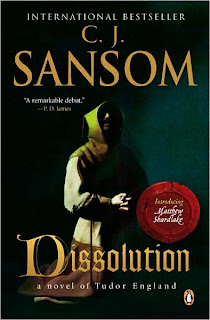By Paul Carrier
Successful lawyer Matthew Shardlake is described by one of his contemporaries in 16th-century London as “the sharpest hunchback in the courts of England.” More importantly, he is an investigator for Thomas Cromwell, King Henry VIII’s ruthless and powerful right hand.
It’s 1537, only a few years after Henry broke from Rome and Parliament proclaimed him head of the Church of England. As religious reforms intensify, Henry angers some of his subjects by forcibly closing small monasteries, yet he believes much more needs to be done to purge the country of its Catholic ways.
To avoid another revolt like that triggered by the mandatory dissolutions, Cromwell is gathering evidence of improprieties at some of the larger monasteries. His goal is to persuade them to shut down voluntarily, or face prosecution.
As part of that process, he sends Robin Singleton, a royal commissioner, to the coastal Benedictine monastery of St. Donatus the Ascendant in Scarnsea, to investigate sexual activities there and the rumored below-market sale of monastery lands. When Singleton is murdered - beheaded, actually - and the monastery’s church is desecrated, Cromwell assigns Shardlake and his clerk, Mark Poer, to investigate.
As a fellow reformer who has served Cromwell in the past, Shardlake is in favor, at least for the time being. But the new commissioner knows how easy it is to fall from grace, especially after Cromwell tells him he has heard reports that Shardlake isn’t as zealous in the cause as he should be.
In fact, Shardlake, who narrates Dissolution, has grown weary of both law and politics, but he knows he must solve the murder or risk alienating his unforgiving patron. His task grows more complex when a novice who tries to tell Shardlake about an earlier murder at the monastery is poisoned before he can elaborate. Later still, the discovery of a corpse proves that the now-dead novice told no lies.
This first entry in C. J. Sansom’s Shardlake series provides plenty of period detail while pulling the reader into the political and theological wrangling that gripped England during the early years of the Reformation. The hostility of traditionalists towards the new order is juxtaposed against the reformers’ zeal in rooting out the excesses of the Catholic Church, such as the inappropriate wealth of the monasteries and their use of dubious relics as money-making devices.
And then there is Shardlake himself, a nuanced protagonist whose keen intellect, inherent decency and thoughtful skepticism are not enough to protect him from the cruelty of people whose superstitious beliefs lead them to fear hunchbanks.
“No doubt they believe hunchbacks bring bad luck,” Shardlake tells Poer after enduring the hard stares of villagers as they travel to Scarnsea. “Oh come, it’s what most people think. I’ve seen men cross themselves at my approach often enough, for all my fine clothes.”
Beyond the immediate task of deciphering who killed whom, Shardlake’s larger dilemma is that he favors Henry's ends - eliminating the decadence and supposed superstitions of the Catholic Church - but he comes to question the means, which include the use of torture to coerce confessions and oaths.
"I'm drawn to (the period) because it's the moment at which the medieval certainties that had endured for centuries were turned upside down,” C. J. Sansom told the British newspaper The Guardian in 2010. “It was a time of extraordinary ferment: in the space of a few years, the state took on a completely different meaning.”
This impressive debut is so atmospheric, and its characters are so varied and believable, that it’s bound to appeal to almost any fan of historical mysteries. Dissolution convincingly portrays a nation consumed by religious turmoil, rigid intolerance, and government-sanctioned cruelty.

